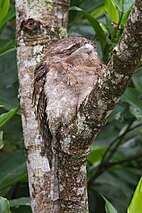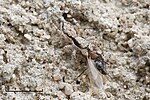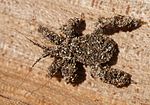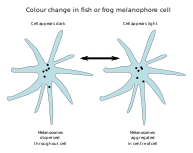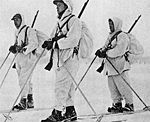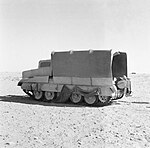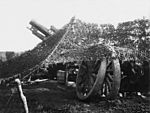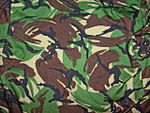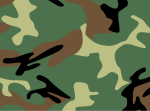Camouflage


Camouflage is the use of any combination of materials, coloration, or illumination for concealment, either by making animals or objects hard to see, or by disguising them as something else. Examples include the
Non-military use of camouflage includes making cell telephone towers less obtrusive and helping hunters to approach wary game animals. Patterns derived from military camouflage are frequently used in fashion clothing, exploiting their strong designs and sometimes their symbolism. Camouflage themes recur in modern art, and both figuratively and literally in science fiction and works of literature.
History
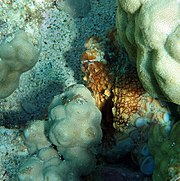
In ancient Greece,
The octopus ... seeks its prey by so changing its colour as to render it like the colour of the stones adjacent to it; it does so also when alarmed.
— Aristotle[1]
Camouflage has been a topic of interest and research in
When we see leaf-eating insects green, and bark-feeders mottled-grey; the alpine ptarmigan white in winter, the
birds of prey; and hawks are guided by eyesight to their prey, so much so, that on parts of the Continent persons are warned not to keep white pigeons, as being the most liable to destruction. Hence I can see no reason to doubt that natural selection might be most effective in giving the proper colour to each kind of grouse, and in keeping that colour, when once acquired, true and constant.[3]
The English zoologist
The artist Abbott Handerson Thayer formulated what is sometimes called Thayer's Law, the principle of countershading.[11] However, he overstated the case in the 1909 book Concealing-Coloration in the Animal Kingdom, arguing that "All patterns and colors whatsoever of all animals that ever preyed or are preyed on are under certain normal circumstances obliterative" (that is, cryptic camouflage), and that "Not one 'mimicry' mark, not one 'warning color'... nor any 'sexually selected' color, exists anywhere in the world where there is not every reason to believe it the very best conceivable device for the concealment of its wearer",[12][13] and using paintings such as Peacock in the Woods (1907) to reinforce his argument.[14] Thayer was roundly mocked for these views by critics including Teddy Roosevelt.[15]
The English zoologist
Experimental evidence that camouflage helps prey avoid being detected by
Evolution
As there is a lack of evidence for camouflage in the fossil record, studying the evolution of camouflage strategies is very difficult. Furthermore, camouflage traits must be both adaptable (provide a fitness gain in a given environment) and heritable (in other words, the trait must undergo positive selection).[21] Thus, studying the evolution of camouflage strategies requires an understanding of the genetic components and various ecological pressures that drive crypsis.
Fossil history
Camouflage is a soft-tissue feature that is rarely preserved in the
Genetics
Camouflage does not have a single genetic origin. However, studying the genetic components of camouflage in specific organisms illuminates the various ways that crypsis can evolve among lineages.
Many cephalopods have the ability to actively camouflage themselves, controlling crypsis through neural activity. For example, the genome of the common cuttlefish includes 16 copies of the reflectin gene, which grants the organism remarkable control over coloration and iridescence.[25] The reflectin gene is thought to have originated through transposition from symbiotic Aliivibrio fischeri bacteria, which provide bioluminescence to its hosts. While not all cephalopods use active camouflage, ancient cephalopods may have inherited the gene horizontally from symbiotic A. fischeri, with divergence occurred through subsequent gene duplication (such as in the case of Sepia officinalis) or gene loss (as with cephalopods with no active camouflage capabilities).[26][3] This is unique as an instance of camouflage arising as an instance of horizontal gene transfer from an endosymbiont. However, other methods of horizontal gene transfer are common in the evolution of camouflage strategies in other lineages. Peppered moths and walking stick insects both have camouflage-related genes that stem from transposition events.[27][28]
The Agouti genes are orthologous genes involved in camouflage across many lineages. They produce yellow and red coloration (phaeomelanin), and work in competition with other genes that produce black (melanin) and brown (eumelanin) colours.[29] In eastern deer mice, over a period of about 8000 years the single agouti gene developed 9 mutations that each made expression of yellow fur stronger under natural selection, and largely eliminated melanin-coding black fur coloration.[30] On the other hand, all black domesticated cats have deletions of the agouti gene that prevent its expression, meaning no yellow or red color is produced. The evolution, history and widespread scope of the agouti gene shows that different organisms often rely on orthologous or even identical genes to develop a variety of camouflage strategies.[31]
Ecology
While camouflage can increase an organism's fitness, it has genetic and energetic costs. There is a trade-off between detectability and mobility. Species camouflaged to fit a specific microhabitat are less likely to be detected when in that microhabitat, but must spend energy to reach, and sometimes to remain in, such areas. Outside the microhabitat, the organism has a higher chance of detection. Generalized camouflage allows species to avoid predation over a wide range of habitat backgrounds, but is less effective. The development of generalized or specialized camouflage strategies is highly dependent on the biotic and abiotic composition of the surrounding environment.[32]
There are many examples of the tradeoffs between specific and general cryptic patterning. Phestilla melanocrachia, a species of nudibranch that feeds on stony coral, utilizes specific cryptic patterning in reef ecosystems. The nudibranch syphons pigments from the consumed coral into the epidermis, adopting the same shade as the consumed coral. This allows the nudibranch to change colour (mostly between black and orange) depending on the coral system that it inhabits. However, P. melanocrachia can only feed and lay eggs on the branches of host-coral, Platygyra carnosa, which limits the geographical range and efficacy in nudibranch nutritional crypsis. Furthermore, the nudibranch colour change is not immediate, and switching between coral hosts when in search for new food or shelter can be costly.[33]
The costs associated with distractive or disruptive crypsis are more complex than the costs associated with background matching. Disruptive patterns distort the body outline, making it harder to precisely identify and locate.[34] However, disruptive patterns result in higher predation.[35] Disruptive patterns that specifically involve visible symmetry (such as in some butterflies) reduce survivability and increase predation.[36] Some researchers argue that because wing-shape and color pattern are genetically linked, it is genetically costly to develop asymmetric wing colorations that would enhance the efficacy of disruptive cryptic patterning. Symmetry does not carry a high survival cost for butterflies and moths that their predators views from above on a homogeneous background, such as the bark of a tree. On the other hand, natural selection drives species with variable backgrounds and habitats to move symmetrical patterns away from the centre of the wing and body, disrupting their predators' symmetry recognition.[37]
Principles
Camouflage can be achieved by different methods, described below. Most of the methods help to hide against a background; but mimesis and motion dazzle protect without hiding. Methods may be applied on their own or in combination. Many mechanisms are visual, but some research has explored the use of techniques against
Background matching
Some animals' colours and patterns match a particular natural background. This is an important component of camouflage in all environments. For instance, tree-dwelling
-
Lion in Kruger National Park, South Africa, blending in with the tall grass
-
Black-faced sandgrouseis coloured like its desert background.
-
Egyptian nightjar nests in open sand with only its camouflaged plumage to protect it.
-
Bright greenkatydidhas the colour of fresh vegetation.
Disruptive coloration
Disruptive patterns use strongly contrasting, non-repeating markings such as spots or stripes to break up the outlines of an animal or military vehicle,[47] or to conceal telltale features, especially by masking the eyes, as in the common frog.[48] Disruptive patterns may use more than one method to defeat visual systems such as edge detection.[49] Predators like the leopard use disruptive camouflage to help them approach prey, while potential prey use it to avoid detection by predators.[50] Disruptive patterning is common in military usage, both for uniforms and for military vehicles. Disruptive patterning, however, does not always achieve crypsis on its own, as an animal or a military target may be given away by factors like shape, shine, and shadow.[51][52][53]
The presence of bold skin markings does not in itself prove that an animal relies on camouflage, as that depends on its behaviour.[54] For example, although giraffes have a high contrast pattern that could be disruptive coloration, the adults are very conspicuous when in the open. Some authors have argued that adult giraffes are cryptic, since when standing among trees and bushes they are hard to see at even a few metres' distance.[55] However, adult giraffes move about to gain the best view of an approaching predator, relying on their size and ability to defend themselves, even from lions, rather than on camouflage.[55] A different explanation is implied by young giraffes being far more vulnerable to predation than adults. More than half of all giraffe calves die within a year,[55] and giraffe mothers hide their newly born calves, which spend much of the time lying down in cover while their mothers are away feeding. The mothers return once a day to feed their calves with milk. Since the presence of a mother nearby does not affect survival, it is argued that these juvenile giraffes must be very well camouflaged; this is supported by coat markings being strongly inherited.[55]
The possibility of camouflage in plants has been little studied until the late 20th century. Leaf variegation with white spots may serve as camouflage in forest understory plants, where there is a dappled background; leaf mottling is correlated with closed habitats. Disruptive camouflage would have a clear evolutionary advantage in plants: they would tend to escape from being eaten by herbivores. Another possibility is that some plants have leaves differently coloured on upper and lower surfaces or on parts such as veins and stalks to make green-camouflaged insects conspicuous, and thus benefit the plants by favouring the removal of herbivores by carnivores. These hypotheses are testable.[56][57][58]
-
Leopard: a disruptively camouflaged predator
-
Russian T-90 battle tank painted in bold disruptive pattern of sand and green
-
Gaboon viper's bold markings are powerfully disruptive.
-
Aptarmiganand five chicks exhibit exceptional disruptive camouflage
-
Jumping spider: a disruptively camouflaged invertebrate predator
-
Many understory plants such as the saw greenbriar, Smilax bona-nox have pale markings, possibly disruptive camouflage.
Eliminating shadow

Some animals, such as the
-
Three countershaded and cryptically coloured ibex almost invisible in the Israeli desert
-
"Shape, shine, shadow" make these 'camouflaged' military vehicles easily visible.
-
The flat-tail horned lizard's body is flattened and fringed to minimise its shadow.
-
Camouflage netting is draped away from a military vehicle to reduce its shadow.
-
A caterpillar's fringe of bristles conceals its shadow.
Distraction
Many prey animals have conspicuous high-contrast markings which paradoxically attract the predator's gaze.
Self-decoration
Some animals actively seek to hide by decorating themselves with materials such as twigs, sand, or pieces of shell from their environment, to break up their outlines, to conceal the features of their bodies, and to match their backgrounds. For example, a caddisfly larva builds a decorated case and lives almost entirely inside it; a decorator crab covers its back with seaweed, sponges, and stones.[64] The nymph of the predatory masked bug uses its hind legs and a 'tarsal fan' to decorate its body with sand or dust. There are two layers of bristles (trichomes) over the body. On these, the nymph spreads an inner layer of fine particles and an outer layer of coarser particles. The camouflage may conceal the bug from both predators and prey.[65][66]
Similar principles can be applied for military purposes, for instance when a sniper wears a ghillie suit designed to be further camouflaged by decoration with materials such as tufts of grass from the sniper's immediate environment. Such suits were used as early as 1916, the British army having adopted "coats of motley hue and stripes of paint" for snipers.[67] Cott takes the example of the larva of the blotched emerald moth, which fixes a screen of fragments of leaves to its specially hooked bristles, to argue that military camouflage uses the same method, pointing out that the "device is ... essentially the same as one widely practised during the Great War for the concealment, not of caterpillars, but of caterpillar-tractors, [gun] battery positions, observation posts and so forth."[68][69]
-
This decorator crab has covered its body with sponges.
-
Sniper in a Ghillie suit with plant materials
-
Reduvius personatus, masked hunter bug nymph, camouflaged with sand grains
-
Soviet tanks under netting dressed with vegetation, 1938
Cryptic behaviour
Movement catches the eye of prey animals on the lookout for predators, and of predators hunting for prey.
Motion camouflage

Most forms of camouflage are ineffective when the camouflaged animal or object moves, because the motion is easily seen by the observing predator, prey or enemy.[74] However, insects such as hoverflies[75] and dragonflies use motion camouflage: the hoverflies to approach possible mates, and the dragonflies to approach rivals when defending territories.[76][77] Motion camouflage is achieved by moving so as to stay on a straight line between the target and a fixed point in the landscape; the pursuer thus appears not to move, but only to loom larger in the target's field of vision.[78] Some insects sway while moving to appear to be blown back and forth by the breeze.
The same method can be used for military purposes, for example by missiles to minimise their risk of detection by an enemy.[75] However, missile engineers, and animals such as bats, use the method mainly for its efficiency rather than camouflage.[79]
-
Male Syritta pipiens hoverflies use motion camouflage to approach females
-
MaleAustralian Emperordragonflies use motion camouflage to approach rivals.
-
Preying mantises exhibiting motion camouflage.
Changeable skin coloration
Animals such as chameleon, frog,[80] flatfish such as the peacock flounder, squid, octopus and even the isopod idotea balthica actively change their skin patterns and colours using special chromatophore cells to resemble their current background, or, as in most chameleons, for signalling.[81] However, Smith's dwarf chameleon does use active colour change for camouflage.[82]
Each chromatophore contains pigment of only one colour. In fish and frogs, colour change is mediated by a type of chromatophore known as
The skins of cephalopods such as the octopus contain complex units, each consisting of a chromatophore with surrounding muscle and nerve cells.[84] The cephalopod chromatophore has all its pigment grains in a small elastic sac, which can be stretched or allowed to relax under the control of the brain to vary its opacity. By controlling chromatophores of different colours, cephalopods can rapidly change their skin patterns and colours.[85][86]
On a longer timescale, animals like the Arctic hare, Arctic fox, stoat, and rock ptarmigan have snow camouflage, changing their coat colour (by moulting and growing new fur or feathers) from brown or grey in the summer to white in the winter; the Arctic fox is the only species in the dog family to do so.[87] However, Arctic hares which live in the far north of Canada, where summer is very short, remain white year-round.[87][88]
The principle of varying coloration either rapidly or with the changing seasons has military applications.
-
Rock ptarmigan, changing colour in springtime. The male is still mostly in winter plumage
-
Norwegian volunteer soldiers in Winter War, 1940, with white camouflage overalls over their uniforms
-
Arctic hares in the low arctic change from brown to white in winter
-
Snow-camouflaged German Marder III jagdpanzer and white-overalled crew and infantry in Russia, 1943
-
Veiled chameleon, Chamaeleo calyptratus, changes colour mainly in relation to mood and for signalling.
-
Adaptiv infrared camouflage lets an armoured vehicle mimic a car.
Countershading

Countershading uses graded colour to counteract the effect of self-shadowing, creating an illusion of flatness. Self-shadowing makes an animal appear darker below than on top, grading from light to dark; countershading 'paints in' tones which are darkest on top, lightest below, making the countershaded animal nearly invisible against a suitable background.
Countershading is less often used for military camouflage, despite Second World War experiments that showed its effectiveness. English
The term countershading has a second meaning unrelated to "Thayer's Law". It is that the upper and undersides of animals such as sharks, and of some military aircraft, are different colours to match the different backgrounds when seen from above or from below. Here the camouflage consists of two surfaces, each with the simple function of providing concealment against a specific background, such as a bright water surface or the sky. The body of a shark or the fuselage of an aircraft is not gradated from light to dark to appear flat when seen from the side. The camouflage methods used are the matching of background colour and pattern, and disruption of outlines.[94]
-
Countershaded Dorcas gazelle, Gazella dorcas
-
Countershaded grey reef shark, Carcharhinus amblyrhynchos
-
Countershaded ship and submarine in Thayer's 1902 patent application
-
Two model birds painted by Thayer: painted in background colours on the left, countershaded and nearly invisible on the right
-
CountershadedFocke-Wulf Fw 190D-9
Counter-illumination
Counter-illumination means producing light to match a background that is brighter than an animal's body or military vehicle; it is a form of active camouflage. It is notably used by some species of
Counterillumination has rarely been used for military purposes. "
-
HMS Largs by night with incomplete diffused lighting camouflage, 1942, set to maximum brightness
-
Bulwark of HMS Largs showing 4 (of about 60) diffused lighting fittings, 2 lifted, 2 deployed
-
Yehudi Lightsraise the average brightness of the plane from a dark shape to the same as the sky.
Transparency

Many marine animals that float near the surface are highly transparent, giving them almost perfect camouflage.[107] However, transparency is difficult for bodies made of materials that have different refractive indices from seawater. Some marine animals such as jellyfish have gelatinous bodies, composed mainly of water; their thick mesogloea is acellular and highly transparent. This conveniently makes them buoyant, but it also makes them large for their muscle mass, so they cannot swim fast, making this form of camouflage a costly trade-off with mobility.[107] Gelatinous planktonic animals are between 50 and 90 percent transparent. A transparency of 50 percent is enough to make an animal invisible to a predator such as cod at a depth of 650 metres (2,130 ft); better transparency is required for invisibility in shallower water, where the light is brighter and predators can see better. For example, a cod can see prey that are 98 percent transparent in optimal lighting in shallow water. Therefore, sufficient transparency for camouflage is more easily achieved in deeper waters.[107]
Some tissues such as
Silvering

Where transparency cannot be achieved, it can be imitated effectively by silvering to make an animal's body highly reflective. At medium depths at sea, light comes from above, so a mirror oriented vertically makes animals such as fish invisible from the side. Most fish in the upper ocean such as sardine and herring are camouflaged by silvering.[110]
The marine hatchetfish is extremely flattened laterally, leaving the body just millimetres thick, and the body is so silvery as to resemble aluminium foil. The mirrors consist of microscopic structures similar to those used to provide structural coloration: stacks of between 5 and 10 crystals of guanine spaced about 1⁄4 of a wavelength apart to interfere constructively and achieve nearly 100 per cent reflection. In the deep waters that the hatchetfish lives in, only blue light with a wavelength of 500 nanometres percolates down and needs to be reflected, so mirrors 125 nanometres apart provide good camouflage.[110]
In fish such as the herring which live in shallower water, the mirrors must reflect a mixture of wavelengths, and the fish accordingly has crystal stacks with a range of different spacings. A further complication for fish with bodies that are rounded in cross-section is that the mirrors would be ineffective if laid flat on the skin, as they would fail to reflect horizontally. The overall mirror effect is achieved with many small reflectors, all oriented vertically.
Ultra-blackness

Some deep sea fishes have very black skin, reflecting under 0.5% of ambient light. This can prevent detection by predators or prey fish which use bioluminescence for illumination. Oneirodes had a particularly black skin which reflected only 0.044% of 480 nm wavelength light. The ultra-blackness is achieved with a thin but continuous layer of particles in the dermis, melanosomes. These particles both absorb most of the light, and are sized and shaped so as to scatter rather than reflect most of the rest. Modelling suggests that this camouflage should reduce the distance at which such a fish can be seen by a factor of 6 compared to a fish with a nominal 2% reflectance. Species with this adaptation are widely dispersed in various orders of the phylogenetic tree of bony fishes (Actinopterygii), implying that natural selection has driven the convergent evolution of ultra-blackness camouflage independently many times.[111]
Mimesis
In
Mimesis is also employed by some
The
-
Peppered moth caterpillars mimic twigs
-
Flower mantis lures its insect prey by mimicking a Phalaenopsis orchid blossom
-
Hooded grasshopper Teratodus monticollis, superbly mimics a leaf with a bright orange border
-
This grasshopper hides from predators by mimicking a dry leaf
-
Armed WW1 Q-ship lured enemy submarines by mimicking a merchantman
-
Cuckoo adult mimics sparrowhawk, giving female time to lay eggs parasitically
-
Cuckoo eggs mimicking smaller eggs, in this case ofreed warbler
-
Wrap-around spider Dolophones mimicking a stick
Motion dazzle
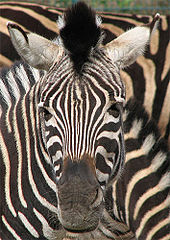
Most forms of camouflage are made ineffective by movement: a deer or grasshopper may be highly cryptic when motionless, but instantly seen when it moves. But one method, motion dazzle, requires rapidly moving bold patterns of contrasting stripes.[122] Motion dazzle may degrade predators' ability to estimate the prey's speed and direction accurately, giving the prey an improved chance of escape.[123] Motion dazzle distorts speed perception and is most effective at high speeds; stripes can also distort perception of size (and so, perceived range to the target). As of 2011, motion dazzle had been proposed for military vehicles, but never applied.[122] Since motion dazzle patterns would make animals more difficult to locate accurately when moving, but easier to see when stationary, there would be an evolutionary trade-off between motion dazzle and crypsis.[123]
An animal that is commonly thought to be dazzle-patterned is the
Applications
Military
Before 1800

Ship camouflage was occasionally used in ancient times.
19th-century origins
The development of military camouflage was driven by the increasing range and accuracy of infantry firearms in the 19th century. In particular the replacement of the inaccurate
In the
During the late 19th century camouflage was applied to British coastal fortifications.[142] The fortifications around Plymouth, England were painted in the late 1880s in "irregular patches of red, brown, yellow and green."[143] From 1891 onwards British coastal artillery was permitted to be painted in suitable colours "to harmonise with the surroundings"[144] and by 1904 it was standard practice that artillery and mountings should be painted with "large irregular patches of different colours selected to suit local conditions."[145]
First World War

In the
-
USS West Mahomet in dazzle camouflage
-
Siege howitzer camouflaged against observation from the air, 1917
-
Austro-Hungarian ski patrol in two-part snow uniforms with improvised head camouflage on Italian front, 1915–1918
Second World War
In the
As in the First World War, artists were pressed into service; for example, the surrealist painter
-
Maritime patrol Catalina, painted white to minimise visibility against the sky
-
1937 summer variant ofWaffen SS FlecktarnPlane tree pattern
-
USS Duluth in naval camouflage Measure 32, Design 11a, one of many dazzle schemes used on warships
-
A Spitfire's underside 'azure' paint scheme, meant to hide it against the sky
-
A Luftwaffe aircraft hangar built to resemble a street of village houses, Belgium, 1944
After 1945
Camouflage has been used to protect military equipment such as vehicles, guns, ships,[156] aircraft and buildings[172] as well as individual soldiers and their positions.[173] Vehicle camouflage methods begin with paint, which offers at best only limited effectiveness. Other methods for stationary land vehicles include covering with improvised materials such as blankets and vegetation, and erecting nets, screens and soft covers which may suitably reflect, scatter or absorb
Many
-
digital camouflagepattern to be issued, in 2002.
-
British Disruptive Pattern Material, issued to special forces in 1963 and universally by 1968
-
2007 2-colour snow variant of Finnish Defence Forces M05 pattern
-
Main (4-colour woodland) variant of ChineseType 99pattern, c. 2006
-
Modern German Flecktarn 1990, developed from a 1938 pattern, a non-digital pattern which works at different distances
-
US "Chocolate Chip"Six-Color Desert Pattern developed in 1962, widely used in Gulf War
Hunting
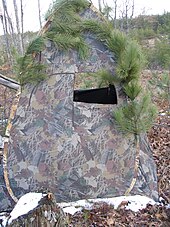
Hunters of game have long made use of camouflage in the form of materials such as animal skins, mud, foliage, and green or brown clothing to enable them to approach wary game animals.[187] Field sports such as driven grouse shooting conceal hunters in hides (also called blinds or shooting butts).[188] Modern hunting clothing makes use of fabrics that provide a disruptive camouflage pattern; for example, in 1986 the hunter Bill Jordan created cryptic clothing for hunters, printed with images of specific kinds of vegetation such as grass and branches.[189]
Civil structures

Camouflage is occasionally used to make built structures less conspicuous: for example, in South Africa, towers carrying cell telephone antennae are sometimes camouflaged as tall trees with plastic branches, in response to "resistance from the community". Since this method is costly (a figure of three times the normal cost is mentioned), alternative forms of camouflage can include using neutral colours or familiar shapes such as cylinders and flagpoles. Conspicuousness can also be reduced by siting masts near, or on, other structures.[190]
Automotive manufacturers often use patterns to disguise upcoming products. This camouflage is designed to obfuscate the vehicle's visual lines, and is used along with padding, covers, and decals. The patterns' purpose is to prevent visual observation (and to a lesser degree photography), that would subsequently enable reproduction of the vehicle's form factors.[191]
Fashion, art and society

Military camouflage patterns influenced fashion and art from the time of the First World War onwards. Gertrude Stein recalled the cubist artist Pablo Picasso's reaction in around 1915:
I very well remember at the beginning of the war being with Picasso on the boulevard Raspail when the first camouflaged truck passed. It was at night, we had heard of camouflage but we had not seen it and Picasso amazed looked at it and then cried out, yes it is we who made it, that is cubism.
— Gertrude Stein in From Picasso (1938)[192]
In 1919, the attendants of a "dazzle ball", hosted by the Chelsea Arts Club, wore dazzle-patterned black and white clothing. The ball influenced fashion and art via postcards and magazine articles.
The scheme of decoration for the great fancy dress ball given by the Chelsea Arts Club at the Albert Hall, the other day, was based on the principles of "Dazzle", the method of "camouflage" used during the war in the painting of ships ... The total effect was brilliant and fantastic.
More recently, fashion designers have often used camouflage fabric for its striking designs, its "patterned disorder" and its symbolism.
Modern artists such as
-
camoufleurs.
-
Camouflage clothing in ananti-war protest, 1971
-
A camouflage skirt as a fashion item, 2007
Notes
- ^ A letter from Alfred Russel Wallace to Darwin of 8 March 1868 mentioned such colour change: "Would you like to see the specimens of pupæ of butterflies whose colours have changed in accordance with the colour of the surrounding objects? They are very curious, and Mr. T. W. Wood, who bred them, would, I am sure, be delighted to bring them to show you."[5]
- ^ Cott explains Beddard's observation as a coincident disruptive pattern.[9]
- ^ Before 1860, unpolluted tree trunks were often covered in pale lichens; polluted trunks were bare, and often nearly black.
- ^ These distraction markings are sometimes called dazzle markings, but have nothing to do with motion dazzle or wartime dazzle painting.
- ^ The belly of the zebra is white, and the dark stripes narrow towards the belly, so the animal is certainly countershaded, but this does not prove that the main function of the stripes is camouflage.
- ^ See Ian Hamilton Finlay#Art.
References
- ^
- ^ Darwin 1859.
- ^ a b Darwin 1859, p. 84.
- ^ Poulton 1890, p. 111.
- ^ Wallace, Alfred Russel (8 March 1868). "Alfred Russel Wallace Letters and Reminiscences By James Marchant". Darwin Online. Retrieved 29 March 2013.
- ^ Poulton 1890, p. Fold-out after p. 339.
- ^ Beddard 1892, p. 83.
- ^ Beddard 1892, p. 87.
- ^ Cott 1940, pp. 74–75.
- ^ Beddard 1892, p. 122.
- ^ Thayer 1909.
- ^ Forbes 2009, p. 77.
- ^ Thayer 1909, pp. 5, 16.
- ^ Rothenberg 2011, pp. 132–133.
- ^ Wright, Patrick (23 June 2005). "Cubist Slugs. Review of DPM: Disruptive Pattern Material; An Encyclopedia of Camouflage: Nature – Military – Culture by Roy Behrens". London Review of Books. 27 (12): 16–20.
- ^ Cott 1940, pp. 172–173.
- ^ Cott 1940, pp. 47–67.
- ^ Cott 1940, pp. 174–186.
- ^ Forbes 2009, pp. 153–155.
- PMID 26822039.
- S2CID 10809290.
- S2CID 4468035.
- ^ Pavid, Katie (28 June 2016). "Oldest insect camouflage behaviour revealed by fossils".
- ^ Watson, Traci (14 September 2016). "This Dinosaur Wore Camouflage". National Geographic Society. Archived from the original on 6 November 2019.
- ISSN 2296-7745.
- S2CID 9974056.
- S2CID 3989607.
- )
- PMID 11837451.
- PMID 29346646.
- S2CID 19021807.
- ISBN 978-0-19-968867-8.
- S2CID 33882835.
- ISBN 978-0-19-968867-8.
- ISSN 1465-7279.
- PMID 16720401.
- PMID 31937221.
- ISSN 2197-7305.
adaptive silence, acoustic crypsis, stealth,
- PMID 26674950.
Field observations of puff adders (Bitis arietans) going undetected by several scent-orientated predator and prey species led us to investigate chemical crypsis in this ambushing species. We trained dogs (Canis familiaris) and meerkats (Suricata suricatta) to test whether a canid and a herpestid predator could detect B. arietans using olfaction.
- ISSN 0028-0836.
cryptic coloration in British field uniforms was not fully adopted until the Boer War
- ^ Cott 1940, pp. 5–19.
- ^ Forbes 2009, p. 51.
- ^ Cott 1940, pp. 5–6.
- ^ Newark 2007, pp. 45–46.
- ^ a b c Cott 1940, p. 17.
- ISBN 978-0-00-220010-3.
- S2CID 16287514.
- ^ Cott 1940, pp. 83–91.
- ^ Osorio, Daniel; Cuthill, Innes C. "Camouflage and perceptual organization in the animal kingdom" (PDF). Archived (PDF) from the original on 29 October 2013. Retrieved 25 October 2013.
- PMID 16959632.
- ISBN 978-0-13-170356-8.
- ^ FM 5–20: Camouflage, Basic Principles. U.S. War Department. November 2015 [1944].
- ^ Field Manual Headquarters No. 20-3 − Camouflage, Concealment, and Decoys (PDF). Department of the Army. 30 August 1999. Archived from the original (PDF) on 17 November 2021.
- hdl:2246/470. Roosevelt attacks Thayer on page 191, arguing that neither zebra nor giraffe are "'adequately obliterated' by countershading or coloration pattern or anything else."
- ^ S2CID 6522531. Archived from the original(PDF) on 23 September 2015. Retrieved 26 April 2012.
- PMID 12957121.
- )
- JSTOR 2389314.
- ^ ISBN 978-0-520-22825-2.
- ^ a b Cott 1940, pp. 104–105.
- ^ U.S. War Department (November 1943). "Principles of Camouflage". Tactical and Technical Trends (37).
- PMID 18990673.
- PMID 19324754.
- ^ Forbes 2009, pp. 50–51 and passim.
- (PDF) from the original on 16 August 2017.
- ^ Bates, Mary (10 June 2015). "Natural Bling: 6 Amazing Animals That Decorate Themselves". National Geographic. Archived from the original on 11 June 2015. Retrieved 11 June 2015.
- ^ Forbes 2009, pp. 102–103.
- ^ Cott 1940, p. 360.
- PMID 26041868.
- ^ a b Cott 1940, p. 141.
- ^ "What is a Horned Lizard?". hornedlizards.org. Horned Lizard Conservation Society. Retrieved 14 November 2015.
- ^ "Leafy Sea Dragon". WWF. Retrieved 21 December 2011.
- .
- ^ Cott 1940, pp. 141–143.
- ^ S2CID 131341953.
- . Retrieved 16 January 2012.
- S2CID 52871328.
- PMID 15129957.
- PMID 16605303.
- ^ Cott 1940, pp. 30–31.
- ^ Forbes 2009, pp. 52, 236.
- PMID 18492645.
- ^ Wallin, M. (2002). "Nature's Palette" (PDF). Bioscience Explained. 1 (2): 1–12. Archived (PDF) from the original on 22 July 2011. Retrieved 17 November 2011.
- ^ Cott 1940, p. 32.
- S2CID 26566732.
- ^ "Day Octopuses, Octopus cyanea". MarineBio Conservation Society. Archived from the original on 20 March 2016. Retrieved 31 January 2013.
- ^ a b "Arctic Wildlife". Churchill Polar Bears. 2011. Retrieved 22 December 2011.
- ^ Hearn, Brian (20 February 2012). The Status of Arctic Hare (Lepus arcticus bangsii) in Insular Newfoundland (PDF). Newfoundland Labrador Department of Environment and Conservation. p. 7. Archived from the original (PDF) on 4 March 2016. Retrieved 3 February 2013.
- ^ "Tanks test infrared invisibility cloak". BBC News. 5 September 2011. Retrieved 13 June 2012.
- ^ "Adaptiv – A Cloak of Invisibility". BAE Systems. 2011. Retrieved 14 November 2015.
- ^ "Innovation Adaptiv Car Signature". BAE Systems. 2012. Retrieved 14 November 2015.
- ^ Cott 1940, pp. 35–46.
- ^ Forbes 2009, pp. 72–73.
- ^ PMID 21227055.
- ^ Cott 1940, p. 41.
- ^ Ehrlich, Paul R.; Dobkin, David S.; Wheye, Darryl (1988). "The Color of Birds". Stanford University. Retrieved 1 February 2013.
- ^ Cott 1940, p. 40.
- ^ Forbes 2009, pp. 146–150.
- ^ Forbes 2009, p. 152.
- ^ Barkas 1952, p. 36.
- ^ Elias 2011, pp. 57–66.
- ^ "Midwater Squid, Abralia veranyi". Smithsonian National Museum of Natural History. Retrieved 28 November 2011.
- ^ Young, Richard Edward (October 1983). "Oceanic Bioluminescence: an Overview of General Functions". Bulletin of Marine Science. 33 (4): 829–845.
- PMID 11079412.
- ^ a b Hambling, David (9 May 2008). "Cloak of Light Makes Drone Invisible?". Wired. Retrieved 17 June 2012.
- ^ a b c d e f g Herring 2002, pp. 190–191.
- ^ a b Cott 1940, p. 6.
- .
- ^ a b c d Herring 2002, pp. 192–195.
- PMID 32679102.
- ISBN 978-1-4443-3036-6.
- ^ Forbes 2009, p. 151.
- ISBN 978-0-801-49906-7.
- ^ Forbes 2009, p. 134.
- ISBN 978-1-55750-044-1.
- ^ McMullen, Chris (2001). "Royal Navy 'Q' Ships". Great War Primary Documents Archive. Retrieved 6 March 2012.
- ^ Forbes 2009, pp. 6–42.
- .
- ^ Brennand, Emma (24 March 2011). "Cuckoo in egg pattern 'arms race'". BBC News. Retrieved 22 August 2011.
- .
- ^ PMID 21673797.
- ^ PMID 22117898.
- ^ Cott 1940, p. 94.
- ^ Thayer 1909, p. 136.
- PMID 18990666.
- ^ Waage, J. K. (1981). "How the zebra got its stripes: biting flies as selective agents in the evolution of zebra colouration". J. Entom. Soc. South Africa. 44: 351–358.
- PMID 22323196.
- PMID 24368147.
- ^ Casson 1995, pp. 211–212.
- ^ Casson 1995, p. 235.
- JSTOR 2563673.
- ^ Payne-Gallwey, Ralph (1903). The Crossbow. Longmans, Green. p. 11.
- ^ Saunders, Nicholas (2005). The People of the Caribbean: An Encyclopedia of Archaeology and Traditional Culture. ABC-CLIO.
- ISBN 978-1841761770.
- ^ Newark 2007, p. 43.
- ^ "Killers in Green Coats". Weider History Group. 20 February 2008. Retrieved 8 July 2012.
- ^ "Khaki Uniform 1848–49: First Introduction by Lumsden and Hodson". Journal of the Society for Army Historical Research. 82 (Winter): 341–347. 2004.
- ^ Hodson, W. S. R. (1859). Hodson, George H. (ed.). Twelve Years of a Soldier's Life in India, being extracts from the letters of the late Major WSR Hodson. John W. Parker and Son.
- ISBN 978-0-85045-849-7.
- ISBN 978-1-84176-399-6.
- ISSN 1367-5907.
- ^ Lewis, JF (1890). Permanent Fortification for English Engineers. The Royal Engineers Institute. p. 280.
- ^ Details of Equipment of Her Majesty's Army Part 2 Section XI B – Garrison Artillery. War Office. 1891.
- ^ Regulations for the equipment of the army. Part 2. section XII (a). War Office. 1904.
- ^ Wright, Patrick (23 June 2005). "Cubist Slugs". London Review of Books. 27 (12): 16–20.
- ^ Guirand de Scévola, Lucien-Victor (December 1949). "Souvenir de Camouflage (1914–1918)". Revue des Deux Mondes (in French).
- ^ Forbes 2009, pp. 104–105.
- ^ "Art of the First World War: André Mare and Leon Underwood". The Elm at Vermezeele. Memorial-Caen. 1998. Archived from the original on 29 May 2013. Retrieved 8 February 2013.
- ^ "Art of the First World War: André Mare". Memorial-Caen. 1998. Archived from the original on 28 May 2013. Retrieved 8 February 2013.
- ^ "Camouflage". Online Etymology Dictionary. 2012. Retrieved 8 February 2013.
- ^ "Camouflage, n". Oxford English Dictionary. Oxford University Press. Retrieved 8 February 2013.
- ^ Forbes 2009, pp. 85–89.
- ^ For Solomon, see BBC Radio 4 programme "Warpaint: the story of camouflage" by Patrick Wright, August 2002 (repeated Radio 4 Extra, 17 June 2014).
- ISBN 978-0-906290-87-3.
- ^ a b c d Sumrall, R. F. (February 1973). "Ship Camouflage (WWII): Deceptive Art". United States Naval Institute Proceedings: 67–81.
- ^ Prinzeugen. "Schnellboot: An Illustrated Technical History". Prinz Eugen. Archived from the original on 19 September 2016. Retrieved 5 March 2012.
- ^ "Obituary: Mr Norman Wilkinson, Inventor of 'dazzle' painting". The Times. 1 June 1971. p. 12.
- ^ Wilkinson, Norman (1969). A Brush with Life. Seeley Service. p. 79.
- ^ Forbes 2009, pp. 149–150.
- ^ Keating, Kenneth C. (1981). "Maskirovka: The Soviet System of Camouflage" (PDF). U.S. Army Russian Institute. Archived (PDF) from the original on 19 May 2014. Retrieved 8 July 2012.
- ISBN 978-0-7553-3639-5.
- ISBN 978-0-87021-059-4.
- ^ Stephenson, Hubert Kirk (1948). Applied Physics, pp. 200, 258. Volume 6 of Science in World War II; Office of Scientific Research and Development. Editors: Chauncey Guy Suits and George Russell Harrison. Little, Brown.
- ISBN 978-0-00-219444-0.
white has proved to be the most efficient concealing coloration for aircraft on anti-submarine patrol
- ^ "World War II". Farnham Castle. Retrieved 8 February 2013.
- ^ Forbes 2009, pp. 151–152.
- ^ Barkas 1952, pp. 154, 186–188.
- ^ Forbes 2009, pp. 156–166.
- ^ Mellor, D. P. (1958). The Role of Science and Industry. Australia in the War of 1939–1945. Series 4 – Civil. Vol. 5. Canberra: Australian War Memorial. p. 538ff.
- ISBN 978-0-8166-9341-2.
- ^ "Concealment, Camouflage, and Deception" (PDF). Smithsonian. pp. 1–4. Archived (PDF) from the original on 14 June 2013. Retrieved 16 June 2012.
- ^ "FM 21–75" (PDF). Chapter 5: Cover, Concealment, and Camouflage. Department of the Army. Archived from the original (PDF) on 26 September 2021. Retrieved 11 June 2023.
- ^ "FM 21-305/AFMAN 24-306" (PDF). Chapter 20: Vehicle Camouflage And Nuclear, Biological, And Chemical Operations. Department of the Army. pp. 1–9. Archived (PDF) from the original on 17 November 2015. Retrieved 16 June 2012.
- ^ "5–103". Appendix D: Camouflage. Department of the Army. Retrieved 17 June 2012.
- ^ "SSZ Camouflage". Military Suppliers & News. 2012. Retrieved 17 June 2012.
- .
- ISBN 978-0-7603-1051-9. Archived from the originalon 7 April 2015. Retrieved 9 September 2017.
- (PDF) from the original on 13 August 2011.
- ^ FM 21–76 US Army Survival Manual. Department of the Army. Retrieved 8 January 2013.
- ^ Photosimulation Camouflage Detection Test. U.S. Army Natick Soldier Research, Development and Engineering Center. 2009. p. 27. Retrieved 5 October 2012.
- ISBN 978-1-84797-137-1.
- ^ Freedberg, S. J. Jr. (25 June 2012). "Army drops universal camouflage after spending billions". AOL Defence. Archived from the original on 31 August 2012. Retrieved 27 September 2012.
- ^ Davies, W. "Berlin Brigade Urban Paint Scheme". Newsletter. Ex-Military Land Rover Association. Archived from the original on 12 March 2013. Retrieved 25 September 2012.
- ^ Craemer, Guy. "Dual Texture – U.S. Army digital camouflage". United Dynamics. Retrieved 27 September 2012.
- ^ Engber, D. (5 July 2012) [2007]. "Lost in the Wilderness, the military's misadventures in pixellated camouflage". Slate. Retrieved 27 September 2012.
- ^ Newark 2007, p. 38.
- ISBN 978-0-8117-0566-0.
- ^ Newark 2007, pp. 48, 50.
- ^ du Plessis, A. (3 July 2002). Telecommunication Mast Management Guidelines for the City of Tshwane. City of Tshwane Metropolitan Municipality.
- ^ "The secrets behind all that camouflage". Automotive News. 12 May 2015. Retrieved 28 July 2015.
- ^ Stein, Gertrude (1939). "Picasso". Translated by Toklas, Alice B. Scribners. Archived from the original on 1 February 2014. Retrieved 31 January 2014.
- ^ a b Forbes 2009, p. 100.
- ^ "The Great Dazzle Ball at the Albert Hall: The Shower of Bomb Balloons and Some Typical Costumes". Illustrated London News. No. 154. 22 March 1919. pp. 414–415.
- ^ "Love and War: The Weaponized Woman". John Galliano for Christian Dior, silk camouflage evening dress. The Museum at FIT. 9 September – 16 December 2006. Archived from the original on 12 December 2012. Retrieved 1 December 2011.
- ^ "Camouflage: The Exhibition". Canadian War Museum. 5 June 2009. Retrieved 14 November 2015.
- ^ "Ian Hamilton Finlay: Arcadia (collaboration with George Oliver)". Arcadia, 1973. Tate. July 2008. Retrieved 11 May 2012.
- ISBN 978-0-441-01161-2.
- ISBN 978-0-87685-857-8.
Bibliography
Camouflage in nature
Early research
- Beddard, Frank Evers (1892). Animal Coloration. Swan Sonnenschein.
- Cott, Hugh B. (1940). Adaptive Coloration in Animals. Methuen.
- Darwin, Charles (1859). On the Origin of Species. John Murray. Reprinted 1985, Penguin Classics.
- Poulton, Edward B. (1890). The Colours of Animals. Kegan Paul, Trench, Trübner.
- Thayer, Abbott Handerson (1909). Concealing-Coloration in the Animal Kingdom Macmillan.
General reading
- Elias, Ann (2011). Camouflage Australia: Art, Nature, Science and War. Sydney University Press. ISBN 978-1-920899-73-8.
- Elias, Ann (2015). Camouflage Cultures: Beyond the Art of Disappearance. Sydney University Press. ISBN 978-1-743324-25-7.
- Forbes, Peter (2009). ISBN 978-0-300-17896-8.
- ISBN 978-0-19-854956-7.
- ISBN 978-1-60819-216-8.
Military camouflage
- Barkas, Geoffrey (1952). The Camouflage Story (from Aintree to Alamein). Cassell.
- ISBN 978-0-8018-5130-8.
- Newark, Tim (2007). Camouflage. Thames and Hudson, with ISBN 978-0-500-51347-7.
Further reading
- ISBN 0-9713244-0-9.
- ISBN 978-0-9713244-6-6.
- ISBN 978-0-9713244-7-3.
- Goodden, Henrietta (2009). Camouflage and Art: Design for Deception in World War 2. Unicorn Press. ISBN 978-0-906290-87-3.
- ISBN 978-1-58567-381-0.
- Newman, Alex; Blechman, Hardy (2004). DPM – Disruptive Pattern Material: An Encyclopaedia of Camouflage: Nature, Military and Culture. DPM. ISBN 978-0-9543404-0-7.
- Shell, Hanna Rose (2012). Hide and Seek: Camouflage, Photography and the Media of Reconnaissance. Zone Books. ISBN 978-1-935-40822-2.
- ISBN 978-0-521-15257-0.
- ISBN 978-0-07-070100-7.
For children
- Kalman, Bobbie; Crossingham, John (2001). What are Camouflage and Mimicry?. Crabtree Publishing. ISBN 978-0-86505-962-7. (ages 4–8)
- Mettler, Rene (2001). Animal Camouflage. First Discovery series. Moonlight Publishing. ISBN 978-1-85103-298-3. (ages 4–8)
External links
- Ohio State University: The Camouflage Project – interplay of science and art
- Behrens, Roy. A Chronology of Camouflage


